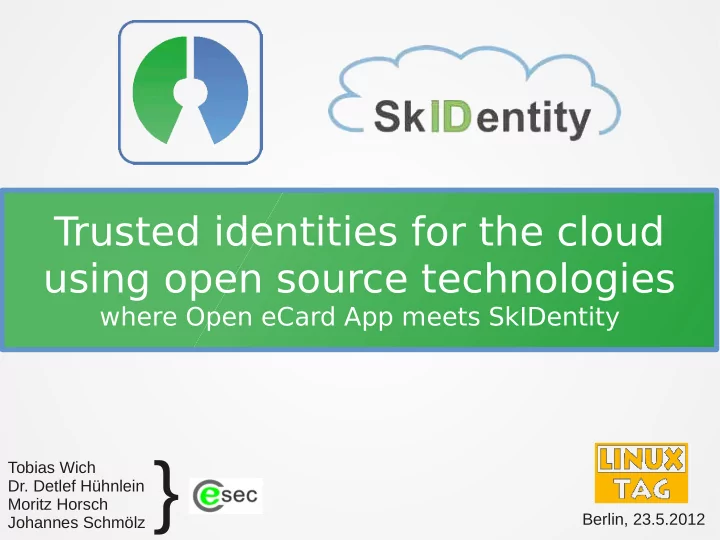

Trusted identities for the cloud using open source technologies where Open eCard App meets SkIDentity Johannes Schmölz } Tobias Wich Dr. Detlef Hühnlein Moritz Horsch Berlin, 23.5.2012
Agenda Introduction Identity Management eCard-API-Framework SkIDentity Open eCard App Summary
Identities ● A „complete identity“ is the sum of all attributes of any entity ● A „digital identity“ ⊂ „complete identity“ ● Or „partial identity“ ● An Identity Management is a system responsible for the attributes of identities ● It creates assertions for partial identities
(Site-)Local IdM Systems ● IdP (Identity Provider) and SP (Service Provider) belong to the same realm ● Not possible to use identity outside realm ● Examples ● /etc/shadow ● Database (SQL/LDAP) ● ...
Federated IdM Systems ● IdP and SP have a trust relationship ● IdP creates assertion of a users identity ● SP can validate and use an assertion ● Examples ● Kerberos ● SAML ● OpenID ● OAuth ● ...
Federated Architecture Identity Provider Client Service Provider
Status Quo Identity Management ● Passwords are (still) standard ● When passwords are simple, then they are ● easy to use ● easy to carry around (knowledge) ● cheap ● Therefore : Identity theft is serious threat ● Phishing, XSS, Sony, … ● In fact even worse with SSO
Authentication T okens to the rescue ● One-Time-Password (OTP) T oken ● Yubikey, Smartphone, ... ● Biometry ● can be strong, but must not be ● X509 is the poor mans smart-card ● Can be seen as hybrid (Possession of knowledge/data) ● But fights XSS, phishing (not all) and Sony ● smart-card + PIN (+ Certificates) ● Cards vary greatly with regard to security
So why is nobody using it? ● Hardware-T okens often use different Protocols ● Few client applications are ready for use with Smart-Card X ● Locked out when token is lost/defect ● Hardware has a price ● High security too
Agenda Introduction Identity Management eCard-API-Framework SkIDentity Open eCard App Summary
eCard-API-Framework „The objective of the eCard-API-Framework is the provision of a simple and homogeneous interface to enable standardised use of the various smart cards (eCards) for different applications.“ In other Words: Network transparent abstractions of smart- cards with XML and SOAP .
eCard-API Architecture
Agenda Introduction Identity Management eCard-API-Framework SkIDentity Open eCard App Summary
Identity + Cloud = SkIDentity
Who is SkIDentity?
Goals of SkIDentity ● Create infrastructure with all components ● Cloud Connector ● Multi Protocol IdP ● eID-Server backends ● Client Application for arbitrary HW-T okens ● Make infrastructure easy to use (for SP) ● Combine multiple identities/providers ● Make it easy enough for users to use and accept HW-T okens
Architecture eID-Server OTP-Server eID-Broker eID-Client Browser CC Service Provider
How could it look like?
What happens next? ● T oken selection ● T o be continued ...
Benefits ● Supports multiple protocols → When e.g. OAuth is integrated, the SP can switch the IdP, or support multiple IdPs ● More tokens supported by enabling the appropriate backend and add a CardInfo file ● Much easier to integrate than n eID-Servers ● Anonymous identities with Site-specific Pseudonyms
Agenda Introduction Identity Management eCard-API-Framework SkIDentity Open eCard App Summary
Existing eCard Clients
What is the problem? ● None has publicly available source ● All free (beer) clients are limited to nPA ● No client has real CardInfo support ● eCard-API is still changing, new features get adopted quite slowly ● Clients in general not non-Web-SSO ready ● Ports to other platforms ● Clients only support Auth and Sign ● ...
Open eCard App - The Facts! ● Dual license (GPLv3 or proprietary) ● Heavily modularized to support pluggable architecture ● Multiple application bundles ● Leightweight design ● Extensible ● Protocols ● Frontend interface (binding) ● Builtin protocol endpoints ● User Consent GUI
T echnical Basis ● Libraries ● Clients in the first release ● Java integrated ● Rich Client for – JAXB, SmartcardIO, Desktops Android NFC, ... ● Bouncycastle ● Applet ● slf4j ● Android
High-Level Design
User Consent Screenshots
User Consent Screenshots
User Consent Screenshots
PIN-entry from IFD
Current Status and Roadmap ● Complete Features ● Dispatcher, Recognition and Event Engine, GUI ● Almost Complete Features ● IFD, SAL, CardInfo support ● Milestone 1.0.0-pre1 ● Feature development of EAC and TLS protocols ● Milestone 1.0.0-pre2 ● Documentation and T esting ● Release 1.0.0 ● Finish Rich Client, Applet and Android app
Participate ● Source will be on GitHub ● What can you do? ● Explore the code and find bugs ● Activation Request Dispatcher ● PKCS12 module ● Nice Qt/GTK GUI ● smart-card Inspector ● … or become part of our team and work on the beefy stuff
Agenda Introduction Identity Management eCard-API-Framework SkIDentity Open eCard App Summary
Summary ● Using Hardware-T okens ● prevents most common attacks ● increases privacy ● With a free OSS App, anybody can ● find and report bugs ● create custom applications ● SkIDentity + Open eCard App ● makes strong identities usable
Thank you for your kind attention!
Recommend
More recommend